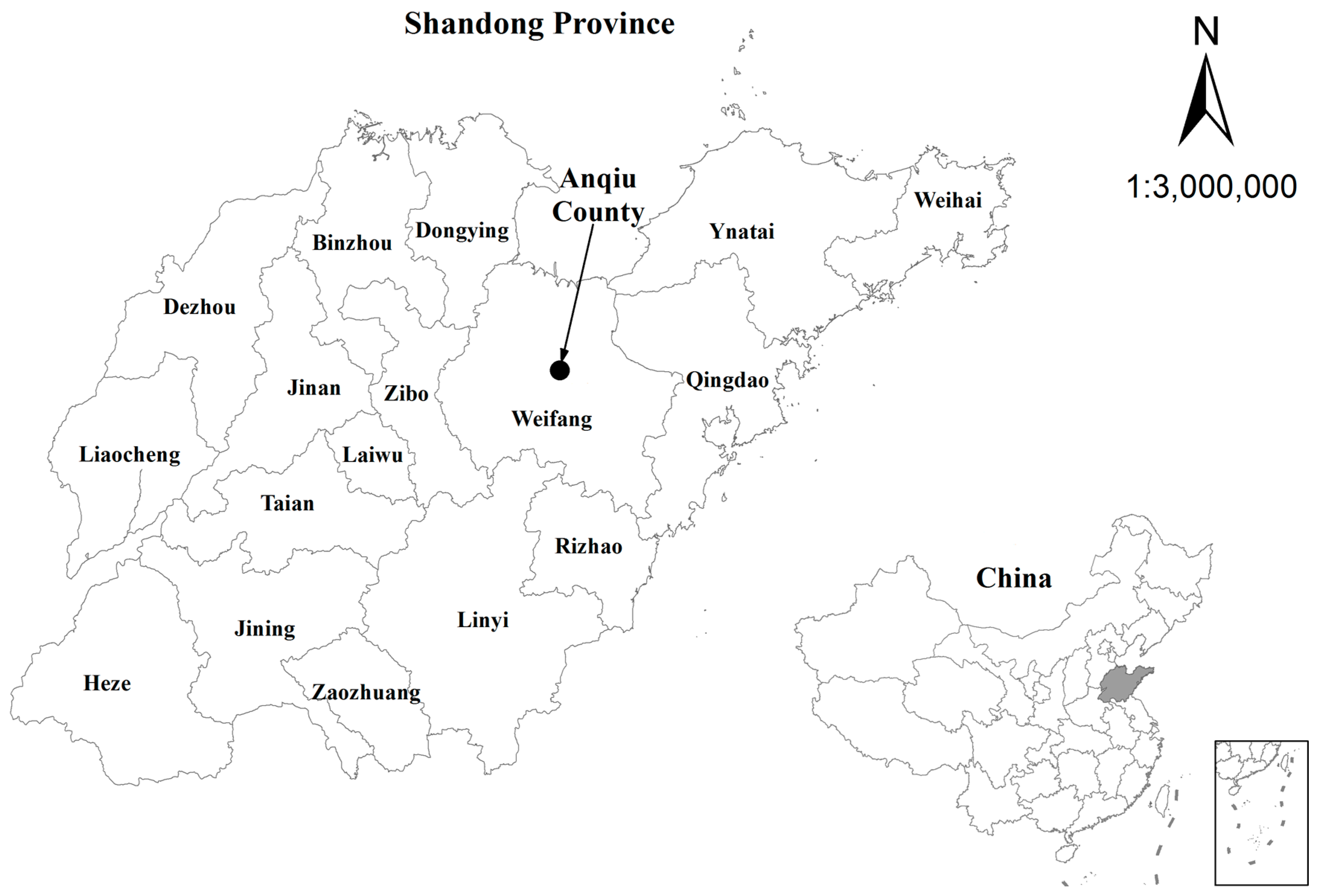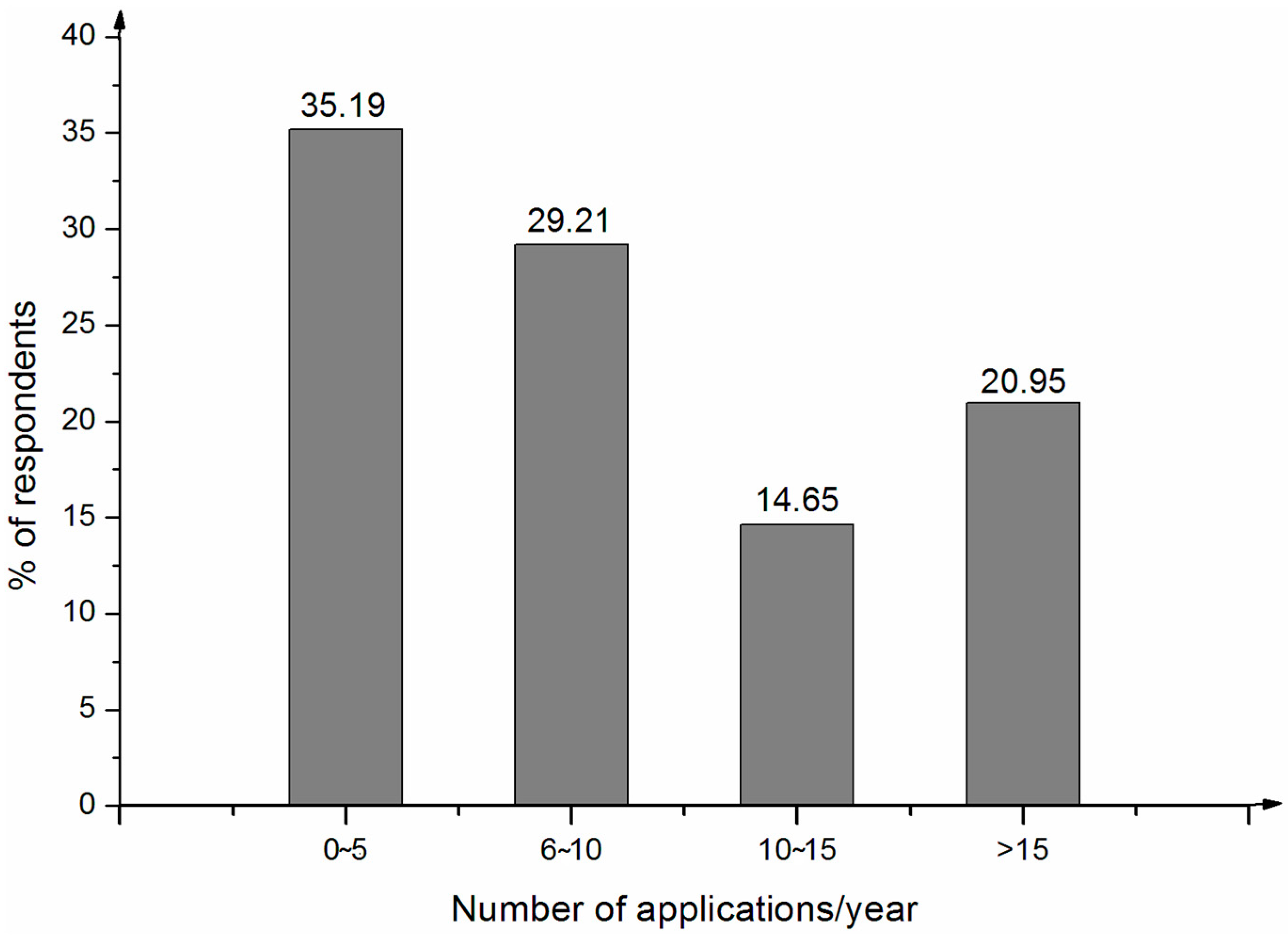Pesticide Use and Risk Perceptions among Small-Scale Farmers in Anqiu County, China
Abstract
:1. Introduction
2. Materials and Methods
2.1. Study Area
- Geographically, the county is located in the central part of the North China Plain. Agricultural production in this area plays an important role in ensuring food security for the country, and Anqiu County has now been identified as the national agricultural standardization demonstration city.
- The county has been adopting high input farming practices, including pesticides. Assessment of such intensive production practices has increasingly attracted the attention of academics, planners and decision-makers.
- The county can be seen as representative of the North China Plain in terms of biophysical, socio-economic and agricultural production conditions.
2.2. Survey Design
2.3. Data Collection
3. Empirical Results and Discussion
3.1. Characteristics of Respondents
3.2. Knowledge of Farmers Regarding Pesticide Use
3.3. Risk Perceptions of Farmers Regarding Pesticide Use
3.4. Pesticide Use Practices of Farmers
3.5. Farmers’ Overuse Behaviors
4. Conclusions
Acknowledgments
Author Contributions
Conflicts of Interest
References
- Beddington, J. Food security, contributions from science to a new and greener revolution. Philos. Trans. R. Soc. Lond. Ser. B Biol. Sci. 2010, 365, 61–71. [Google Scholar] [CrossRef] [PubMed]
- Rahman, S. Pesticide consumption and productivity and the potential of IPM in Bangladesh. Sci. Total Environ. 2013, 445, 48–56. [Google Scholar] [CrossRef] [PubMed]
- Damalas, C.A. Understanding benefits and risk of pesticide use. Sci. Res. Essays 2009, 4, 945–949. [Google Scholar]
- Hvistendahl, M. In rural Asia, locking up poisons to prevent suicides. Science 2013, 341, 738–739. [Google Scholar] [CrossRef] [PubMed]
- Verger, P.J.; Boobis, A.R. Reevaluate pesticides for food security and safety. Science 2013, 341, 717–718. [Google Scholar] [CrossRef] [PubMed]
- Zhang, C.; Hu, R.; Shi, G.; Jin, Y.; Robson, M.G.; Huang, X. Overuse or underuse? An observation of pesticide use in China. Sci. Total Environ. 2015, 538, 1–6. [Google Scholar] [CrossRef] [PubMed]
- Li, H.; Zeng, E.Y.; You, J. Mitigating Pesticide Pollution in China Requires Law Enforcement, Farmer Training, and Technological Innovation. Environ. Toxicol. Chem. 2014, 33, 963–971. [Google Scholar] [CrossRef] [PubMed]
- Khan, M.; Damalas, C.A. Farmers’ willingness to pay for less health risks by pesticide use: A case study from the cotton belt of Punjab, Pakistan. Sci. Total Environ. 2015, 530–531, 297–303. [Google Scholar] [CrossRef] [PubMed]
- Gong, Y.; Baylis, K.; Kozak, R.; Bull, G. Farmers’ risk preferences and pesticide use decisions: Evidence from field experiments in China. Agric. Econ. 2016, 47, 411–421. [Google Scholar] [CrossRef]
- Fan, S.; Brzeska, J.; Keyzer, M.; Halsema, A. From Subsistence to Profits: Transforming Smallholder Farms; International Food Policy Research Institute: Washington, DC, USA, 2013. [Google Scholar]
- Zhang, H.; Lu, Y. End-users’ knowledge, attitude, and behavior towards safe use of pesticides, a case study in the Guanting Reservoir area, China. Environ. Geochem. Health 2007, 29, 513–520. [Google Scholar] [CrossRef] [PubMed]
- Food and Agriculture Organization of the United Nations. Guidelines to Control Water Pollution from Agriculture in China, Decoupling Water Pollution from Agricultural Production; FAO: Rome, Italy, 2013. [Google Scholar]
- Zhou, L.; Liu, L.; Chang, L.; Li, L. Poisoning deaths in Central China (Hubei), a 10-year retrospective study of forensic autopsy cases. J. Forensic. Sci. 2011, 56 (Suppl. S1), 234–237. [Google Scholar] [CrossRef] [PubMed]
- Chen, R.; Huang, J.; Qiao, F. Farmers’ knowledge on pest management and pesticide use in Bt cotton production in China. China Econ. Rev. 2013, 27, 15–24. [Google Scholar] [CrossRef]
- Liu, E.M.; Huang, J.K. Risk preferences and pesticide use by cotton farmers in China. J. Dev. Econ. 2013, 103, 202–215. [Google Scholar] [CrossRef]
- Jin, S.; Bluemling, B.; Mol, A.P.J. Information, trust and pesticide overuse: Interactions between retailers and cotton farmers in China. NJAS Wagening. J. Life Sci. 2015, 72–73, 23–32. [Google Scholar] [CrossRef]
- Yang, P.; Iles, M.; Yan, S.; Jolliffe, F. Farmers’ knowledge, perceptions and practices in transgenic Bt cotton in small producer systems in Northern China. Crop Prot. 2005, 24, 229–239. [Google Scholar] [CrossRef]
- Togbe, C.E.; Zannou, E.T.; Vodouhe, S.D.; Haagsma, R.; Gbehounou, G.; Kossou, D.K.; van Huis, A. Technical and institutional constraints of a cotton pest management strategy in Benin. NJAS Wagening. J. Life Sci. 2012, 60–63, 67–78. [Google Scholar] [CrossRef]
- Kishi, M.; Hirschhorn, N.; Djajadisastra, M.; Satterlee, L.N.; Strowman, S.; Dilts, R. Relationship of pesticide spraying to signs and symptoms in Indonesian farmers. Scand. J. Work Environ. Health 1995, 21, 124–133. [Google Scholar] [CrossRef] [PubMed]
- Sun, B.; Zhang, L.; Yang, L.; Zhang, F.; Norse, D.; Zhu, Z. Agricultural Non-PointSource Pollution in China: Causes and Mitigation Measures. Ambio 2012, 41, 370–379. [Google Scholar] [CrossRef] [PubMed]
- Yang, X.; Wang, F.; Meng, L.; Zhang, W.; Fan, L.; Geissen, V.; Ritsema, C.J. Farmer and retailer knowledge and awareness of the risks from pesticide use: A case study in the Wei River catchment, China. Sci. Total Environ. 2014, 497–498, 172–179. [Google Scholar] [CrossRef] [PubMed]
- Matthews, G.A. Attitudes and behaviors regarding use of crop protection products—A survey of more than 8500 smallholders in 26 countries. Crop Prot. 2008, 27, 834–846. [Google Scholar] [CrossRef]
- Panda, A.; Sharma, U.; Ninan, K.N.; Patt, A. Adaptive capacity contributing to improved agricultural productivity at the household level: Empirical findings highlighting the importance of crop insurance. Glob. Environ. Chang. 2013, 23, 782–790. [Google Scholar] [CrossRef]
- Solomon, B.; Agwata, J.; Anyango, S. Determinants of adoption choices of climate change adaptation strategies in crop production by small scale farmers in some regions of central Ethiopia. J. Nat. Sci. Res. 2014, 4, 78–92. [Google Scholar]
- Damalas, C.A.; Hashemi, S.M. Pesticide risk perception and use of personal protective equipment among young and old cotton growers in northern Greece. Agrociencia 2010, 44, 363–371. [Google Scholar]
- Hashemi, S.M.; Rostami, R.; Hashemi, M.K.; Damalas, C.A. Pesticide use and risk perceptions among farmers in southwest Iran. Hum. Ecol. Risk Assess. 2012, 18, 456–470. [Google Scholar] [CrossRef]
- Dasgupta, S.; Meisne, C.; Huq, M. A Pinch or a Pint? Evidence of Pesticide Overuse in Bangladesh. J. Agric. Econ. 2007, 58, 91–114. [Google Scholar] [CrossRef]
- Zyoud, S.H.; Sawalha, A.F.; Sweileh, W.M.; Awang, R.; AI-Khalil, S.I.; AI-Jabi, S.W.; Bsharat, N.M. Knowledge and practices of pesticide use among farm workers in the West Bank, Palestine: Safety implications. Environ. Health Prev. Med. 2010, 15, 252–261. [Google Scholar] [CrossRef] [PubMed]
- Fan, L.; Niu, H.; Yang, X.; Qin, W.; Bento, C.P.M.; Ritsema, C.J.; Geissen, V. Factors affecting farmers’ behaviour in pesticide use: Insights from a field study in northern China. Sci. Total Environ. 2015, 537, 360–368. [Google Scholar] [CrossRef] [PubMed]
- Midega, C.A.O.; Nyang’au, I.M.; Pittchar, J.; Birkett, M.A.; Pickett, J.A.; Borges, M.; Khan, Z.R. Farmers’ perceptions of cotton pests and their management in western Kenya. Crop Prot. 2012, 42, 193–201. [Google Scholar] [CrossRef]
- Ngowi, A.V.; Mbise, T.J.; Ijani, A.S.; London, L.; Ajayi, O.C. Pesticides use by smallholder farmers in vegetable production in Northern Tanzania. Crop Prot. 2007, 26, 1617–1624. [Google Scholar] [CrossRef] [PubMed]
- Huang, J.; Rozelle, S.; Pray, C.E.; Wang, Q. Plant biotechnology in the developing world: The case of China. Science 2002, 295, 674–677. [Google Scholar] [CrossRef] [PubMed]


| Variable | Mean | Standard Deviation | Min | Max |
|---|---|---|---|---|
| Male respondent | 0.71 | 0.45 | 0 | 1 |
| Age of the respondent | 52.73 | 10.03 | 18 | 86 |
| Marry status | 1.00 | 0.00 | 1 | 1 |
| Total household members | 3.82 | 1.50 | 1 | 10 |
| Total household income (CNY/month) | 3621 | 3057 | 250 | 17,500 |
| Total farm area (ha/household) | 0.60 | 1.02 | 0.31 | 20 |
| Statements | 5 | 4 | 3 | 2 | 1 |
|---|---|---|---|---|---|
| The use of pesticides in food production reduces the safety of food. | 42.77 | 40.70 | 6.84 | 7.31 | 2.38 |
| Pesticide use will have adverse effects on the environment. | 45.87 | 37.78 | 6.19 | 7.30 | 2.86 |
| Pesticide use have harmful effects on human health. | 45.71 | 43.17 | 5.24 | 4.76 | 1.11 |
| A larger amount of pesticide use will have better effects on pest control. | 12.86 | 12.54 | 11.43 | 37.30 | 25.87 |
| Pesticide use will have negative effects on my health. | 40.63 | 41.43 | 9.87 | 5.71 | 2.38 |
| I know the pesticide safety interval period. | 12.38 | 59.52 | 10.48 | 16.67 | 0.95 |
| Source | Percent (%) |
|---|---|
| Communication between other farmers | 45.24 |
| Government extension services | 10.95 |
| Pesticide retailers | 34.44 |
| Media | 9.35 |
| Risk Perception | No. Farmers | Percentage |
|---|---|---|
| Extremely high level of risk | 100 | 15.87 |
| Large level of risk | 211 | 33.49 |
| Medium level of risk | 160 | 25.40 |
| Some small level of risk | 147 | 23.33 |
| No risk at all | 12 | 1.90 |
| Variable | Description | Estimate | Standard Error | p-Value | |
|---|---|---|---|---|---|
| Risk | Risk perception (1 = no risk, 2 = small risk, 3 = medium risk, 4 = high risk and 5 = extremely high risk) | −0.10 ** | 0.05 | 0.051 | |
| Reduction | Willingness to reduce pesticide use (1 = yes; 0 = otherwise) | −0.29 *** | 0.11 | 0.010 | |
| Read | Reading labels on pesticide containers (1 = yes, 0 = no) | −0.73 *** | 0.16 | 0.000 | |
| Governance | Local government having a strict supervision on pesticide use (1 = extremely strict; 2 = strict; 3 = moderate; 4 = loose; 5 = extremely loose) | 0.10 * | 0.06 | 0.088 | |
| Farmyears | Years of farming experience | 0.01 ** | 0.00 | 0.02 | |
| Income | Monthly income of the respondent (CNY 1000) | −0.07 * | 0.04 | 0.086 | |
| Relationship | Better relationships with other villagers (1 = extremely bad; 2 = bad; 3 = moderate; 4 = good; 5 = extremely good) | −0.19 ** | 0.08 | 0.024 | |
| Knowledge | Knowledge score | 0.06 | 0.05 | 0.191 | |
| Constant | 0.61 | 0.50 | 0.224 | ||
| Summary statistics | |||||
| Log likelihood | −353.34 | ||||
| LR chi-squared [9] | 66.36 | ||||
| Prob > chi2 | 0.000 | ||||
| Observations | 630 | ||||
© 2016 by the authors; licensee MDPI, Basel, Switzerland. This article is an open access article distributed under the terms and conditions of the Creative Commons Attribution (CC-BY) license (http://creativecommons.org/licenses/by/4.0/).
Share and Cite
Jin, J.; Wang, W.; He, R.; Gong, H. Pesticide Use and Risk Perceptions among Small-Scale Farmers in Anqiu County, China. Int. J. Environ. Res. Public Health 2017, 14, 29. https://doi.org/10.3390/ijerph14010029
Jin J, Wang W, He R, Gong H. Pesticide Use and Risk Perceptions among Small-Scale Farmers in Anqiu County, China. International Journal of Environmental Research and Public Health. 2017; 14(1):29. https://doi.org/10.3390/ijerph14010029
Chicago/Turabian StyleJin, Jianjun, Wenyu Wang, Rui He, and Haozhou Gong. 2017. "Pesticide Use and Risk Perceptions among Small-Scale Farmers in Anqiu County, China" International Journal of Environmental Research and Public Health 14, no. 1: 29. https://doi.org/10.3390/ijerph14010029
APA StyleJin, J., Wang, W., He, R., & Gong, H. (2017). Pesticide Use and Risk Perceptions among Small-Scale Farmers in Anqiu County, China. International Journal of Environmental Research and Public Health, 14(1), 29. https://doi.org/10.3390/ijerph14010029





